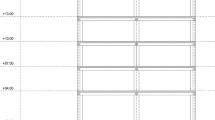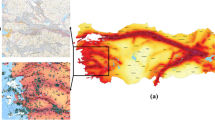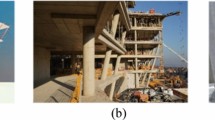Abstract
A series of comprehensive parametric studies are conducted on a steel-frame structure Finite-Element (FE) model with the Multangular-Pyramid Concave Friction System (MPCFS) installed as isolators. This new introduced MPCFS system has some distinctive features when compared with conventional isolation techniques, such as increased uplift stability, improved self-centering capacity, non-resonance when subjected to near-fault earthquakes, and so on. The FE model of the MPCFS is first established and evaluated by comparison between numerical and theoretical results. The MPCFS FE model is then incorporated in a steel-frame structural model, which is subjected to three chosen earthquakes, to verify its seismic isolation. Further, parametric study with varying controlling parameters, such as isolation foundation, inclination angle, friction coefficient, and earthquake input, is carried out to extract more detailed dynamic response of the MPCFS structure. Finally, limitations of this study are discussed, and conclusions are made. The simulations testify the significant seismic isolation of the MPCFS. This indicates the MPCFS, viewed as the beneficial complementary of the existing well-established and matured isolation techniques, may be a promising tool for seismic isolation of near-fault earthquake prone zones. This verified MPCFS FE model can be incorporated in future FE analysis. The results in this research can also guide future optimal parameter design of the MPCFS.
Similar content being viewed by others
References
Kelly J M. Earthquake-Resistant Design with Rubber. 2nd ed. 1997. New York: Springer, 2011
Attary N, Symans M, Nagarajaiah S, Reinhorn A M, Constantinou M C, Sarlis A A, Pasala D T R, Taylor D. Performance evaluation of negative stiffness devices for seismic response control of bridge structures via experimental shake table tests. Journal of Earthquake Engineering, 2015, 19(2): 249–276
Wei B, Wang P, Liu W, Yang M, Jiang L. The impact of the concave distribution of rolling friction coefficient on the seismic isolation performance of a spring-rolling system. International Journal of Non-linear Mechanics, 2016, 83: 65–77
Wei B, Wang P, Yang M, Jiang L. Seismic response of rolling isolation systems with concave friction distribution. Journal of Earthquake Engineering, 2017, 21(2): 325–342
Chen X, Yang T Y, Shi W. Influence of isolation hysteresis on the seismic performance of isolated buildings. Structural Control and Health Monitoring, 2015, 22(4): 631–647
Cheng C T, Chao C H. Seismic behavior of rocking base-isolated structures. Engineering Structures, 2017, 139: 46–58
Guay L P, Bouaanani N. Assessment of low temperature exposure for design and evaluation of elastomeric bridge bearings and seismic isolators in Canada. Canadian Journal of Civil Engineering, 2016, 43(9): 851–863
Ismail M. An isolation system for limited seismic gaps in near-fault zones. Earthquake Engineering & Structural Dynamics, 2015, 44(7): 1115–1137
Ismail M, Rodellar J, Pozo F. An isolation device for near-fault ground motions. Structural Control and Health Monitoring, 2014, 21(3): 249–268
Lin T K, Lu L Y, Chang H. Fuzzy logic control of a stiffness-adaptable seismic isolation system. Structural Control and Health Monitoring, 2015, 22(1): 177–195
Lu L Y, Lee T Y, Yeh S W. Theory and experimental study for sliding isolators with variable curvature. Earthquake Engineering & Structural Dynamics, 2011, 40(14): 1609–1627
Lu L Y, Hsu C C. Experimental study of variable-frequency rocking bearings for near-fault seismic isolation. Engineering Structures, 2013, 46: 116–129
Tsang H H. Seismic isolation by rubber-soil mixtures for developing countries. Earthquake Engineering & Structural Dynamics, 2008, 37(2): 283–303
Tsang H H, Lo S H, Xu X, Neaz Sheikh M. Seismic isolation for low-to-medium-rise buildings using granulated rubber-soil mixtures: numerical study. Earthquake Engineering & Structural Dynamics, 2012, 41(14): 2009–2024
Xiong W, Li Y. Seismic isolation using granulated tire-soil mixtures for less-developed regions: Experimental validation. Earthquake Engineering & Structural Dynamics, 2013, 42(14): 2187–2193
Castaldo P, Amendola G, Palazzo B. Seismic fragility and reliability of structures isolated by friction pendulum devices. Earthquake Engineering & Structural Dynamics, 2017, 46(3): 425–446
Castaldo P, Palazzo B, Ferrentino T. Seismic reliability-based ductility demand evaluation for inelastic base-isolated structures with friction pendulum devices. Earthquake Engineering & Structural Dynamics, 2017, 46(8): 1245–1266
Li C, Jie J, Jiang L Z, Yang T Y. Theory and implementation of a two-step unconditionally stable explicit integration algorithm for vibration analysis of structures. Shock and Vibration, 2016, 2016: 2831206
Saitoh M. An external rotary friction device for displacement mitigation in base isolation systems. Structural Control and Health Monitoring, 2014, 21(2): 173–188
Sarlis A A, Constantinou M C. A model of triple friction pendulum bearing for general geometric and frictional parameters. Earthquake Engineering & Structural Dynamics, 2016, 45(11): 1837–1853
Wolff E D, Ipek C, Constantinou M C, Morillas L. Torsional response of seismically isolated structures revisited. Engineering Structures, 2014, 59: 462–468
Wang S J, Hwang J S, Chang K C, Shiau C Y, Lin W C, Tsai M S, Hong J X, Yang Y H. Sloped multi-roller isolation devices for seismic protection of equipment and facilities. Earthquake Engineering & Structural Dynamics, 2014, 43(10): 1443–1461
Chen P C, Wang S J. Improved control performance of sloped rolling-type isolation devices using embedded electromagnets. Structural Control and Health Monitoring, 2017, 24(1): e1853
Siringoringo D M, Fujino Y. Seismic response analyses of an asymmetric base-isolated building during the 2011 Great East Japan (Tohoku) Earthquake. Structural Control and Health Monitoring, 2015, 22(1): 71–90
Heaton T H, Hall J F, Wald D J, Halling M W. Response of high-rise and base-isolated buildings to a hypothetical Mw 7.0 blind thrust earthquake. Science, 1995, 267(5195): 206–211
Xiong W, Zhang S J, Jiang L Z, Li Y Z. Introduction of the convex friction system (CFS) for seismic isolation. Structural Control and Health Monitoring, 2017, 24(1): e1861
Xiong W, Zhang S J, Jiang L Z, Li Y Z. The Multangular-Pyramid Concave Friction System (MPCFS) for seismic isolation: A preliminary numerical study. Engineering Structures, 2018, 160: 383–394
Abaqus 6.13 Documentation. Extracted from website of Abaqus. 2019
Zhou S, Zhuang X, Rabczuk T. Phase-field modeling of fluid-driven dynamic cracking in porous media. Computer Methods in Applied Mechanics and Engineering, 2019, 350: 169–198
Zhou S, Zhuang X, Rabczuk T. Phase field modeling of brittle compressive-shear fractures in rock-like materials: A new driving force and a hybrid formulation. Computer Methods in Applied Mechanics and Engineering, 2019, 355: 729–752
Zhou S, Rabczuk T, Zhuang X. Phase field modeling of quasi-static and dynamic crack propagation: COMSOL implementation and case studies. Advances in Engineering Software, 2018, 122: 31–49
Zhou S, Zhuang X, Rabczuk T. A phase-field modeling approach of fracture propagation in poroelastic media. Engineering Geology, 2018, 240: 189–203
Zhou S, Zhuang X, Zhu H, Rabczuk T. Phase field modelling of crack propagation, branching and coalescence in rocks. Theoretical and Applied Fracture Mechanics, 2018, 96: 174–192
Acknowledgements
This research was financially supported by the National Natural Science Foundation of China (Grant No. 51108467) and the China Postdoctoral Science Foundation (No. 2014M562131). The authors would express their sincere gratitude to the referees for their warm-hearted and gracious comments.
Author information
Authors and Affiliations
Corresponding author
Rights and permissions
About this article
Cite this article
Xiong, W., Zhang, SJ., Jiang, LZ. et al. Parametric study on the Multangular-Pyramid Concave Friction System (MPCFS) for seismic isolation. Front. Struct. Civ. Eng. 14, 1152–1165 (2020). https://doi.org/10.1007/s11709-020-0659-7
Received:
Accepted:
Published:
Issue Date:
DOI: https://doi.org/10.1007/s11709-020-0659-7




